The Association of Certificated students
In February 1880, a group of dedicated former students founded the ‘Girton College Association of Certificated Students’. Immediately popular, the GCACS was the forerunner of the Roll (Girton’s alumni association). Its first Secretary was Gertrude Jackson (1858–1920), later resident Junior Bursar at the College.
The Association kept Girtonians in touch with each other, increased their role in College affairs, and raised money for key causes, such as Research Studentships and enlarged sports facilities.
In time, this would include the swimming pool. Regular meetings were organised in London and at College, together with sports matches between current and former students. In 1898 the first printed membership list was produced, with a bright blue cover and gold lettering.
 Printed booklet listing the members of the Association of Certificated Students, 1898 (archive reference: GCAS 1/2/2)
Printed booklet listing the members of the Association of Certificated Students, 1898 (archive reference: GCAS 1/2/2)
Elizabeth Welsh
In 1885, Elizabeth Welsh (1843–1921) was appointed the sixth Mistress of the College, the first former student of Girton to hold the post. All the early Mistresses faced the daily challenge of sustaining the young College and its educational ideals.
It was during Miss Welsh’s tenure that Girton faced the crushing defeat of the 1897 Cambridge vote on women’s degrees. But this did not diminish her reputation in the eyes of Girtonians, who remembered her as a kindly and hardworking adviser and the host of memorable parties. She helped to landscape the gardens and reputedly wrote the best College songs.
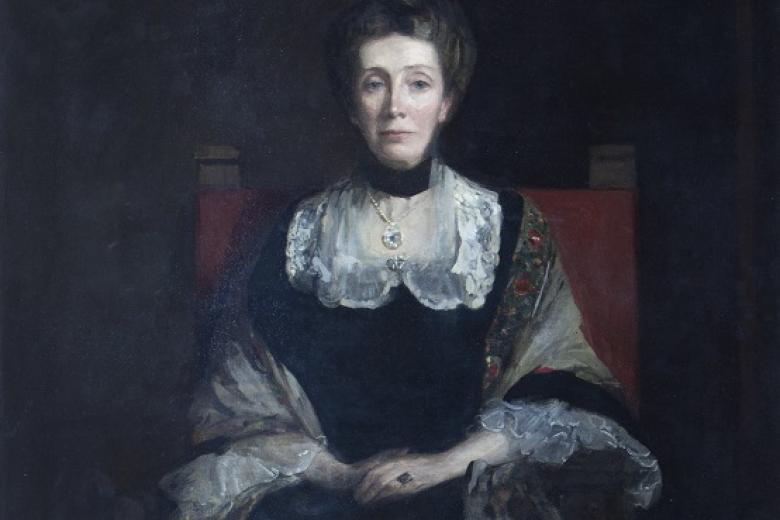 Portrait of Elizabeth Welsh by Sir John Lavery, 1904 (Archive reference: GCPH 11-33-50)
Portrait of Elizabeth Welsh by Sir John Lavery, 1904 (Archive reference: GCPH 11-33-50)
Lady Stanley of Alderley and Henry Tomkinson
Girton was created by the hard work and generosity of a campaigning group of women and men. Particularly important were Henry Tomkinson (1831–1906), and Henrietta, Lady Stanley of Alderley (1807–1895); in time both would be immortalised in the College coat of arms.
Lady Stanley, a wealthy widow, was passionate in her support, and left her mark on key elements of the estate. Among her gifts, she funded the first College ‘chemical laboratory’ in 1877, and gave £1,000 towards the first Library, named after her in 1895. Here, students are at work in the Stanley Library.
Henry Tomkinson was a wise and trusted friend to Emily Davies, Treasurer of the College from 1869 to 1875, and its loyal supporter until his death. A former Cambridge ‘Wrangler’ (a top student in mathematics) he brought financial acumen and many useful contacts to the cause.
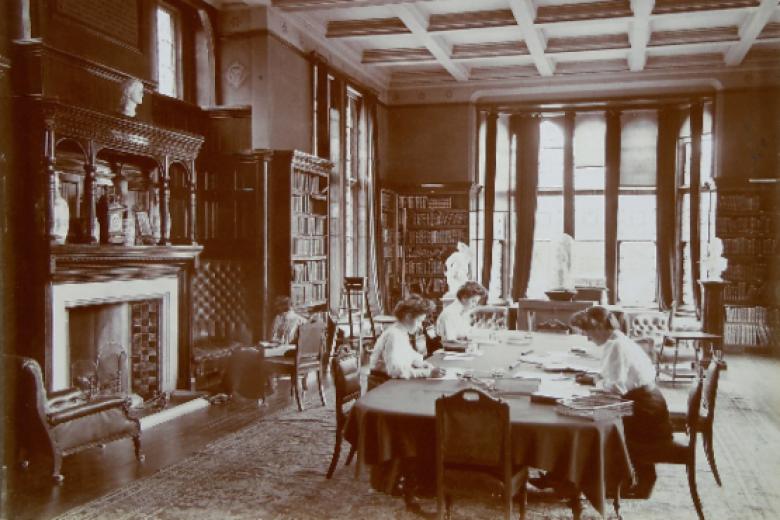 Students studying in the Stanley Library, 1902 (archive reference: GCPH 2/5/6)
Students studying in the Stanley Library, 1902 (archive reference: GCPH 2/5/6)
Sport at Girton
From the College’s earliest days, sport was an important part of student life. At Benslow House, students took part in gymnastics, played ‘Fives’ in the gardens, and went swimming in a local pool.
Gymnastics continued at Girton under a pioneering gymnastics teacher, Martina Bergman-Österberg (1849–1915). Sports clubs and teams quickly emerged, with lawn tennis an early favourite. Tennis was first played outside the Dining Hall and later in Emily Davies Court, as seen here.
By 1900 there were Girton clubs for tennis, hockey, lacrosse, golf, racquets, bicycling and cricket, and the students eagerly awaited the opening of the new indoor swimming pool.
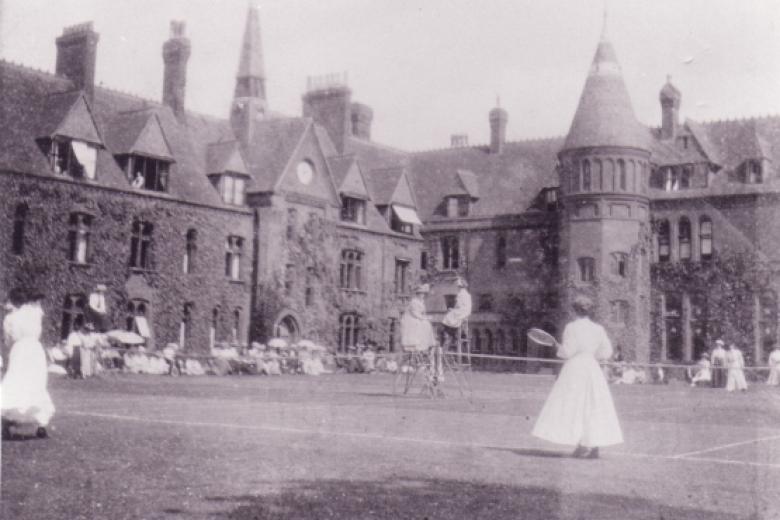 Tennis match on Emily Davies Court, June 1908 (archive reference: GCPH 7/1/84)
Tennis match on Emily Davies Court, June 1908 (archive reference: GCPH 7/1/84)
Steamboat Ladies
From 1904 to 1907, 315 Girtonians received degrees, but not from Cambridge University. In those years, Trinity College Dublin granted women who had met the requirements for degrees from Oxford and Cambridge the right to receive Dublin degrees. Those who took up this offer paid £10.3s for the privilege plus the cost of hiring academic dress. Dublin put this money towards building a Hall of Residence for its own women students.
The Oxford and Cambridge women were known as ‘the Steamboat Ladies’ because most travelled to Ireland by the Holyhead ferry. Pictured here is a group of Cambridge women on the steps of the Trinity College Dining Hall. It includes: Eleanor Allen (1867–1929), at this time Bursar of Girton; Mary Clover (1876–1965), College Secretary; Margaret Meyer (1862–1924), Resident Lecturer in Mathematics; and Katharine Jex-Blake (1860–1951), a future Mistress of Girton.
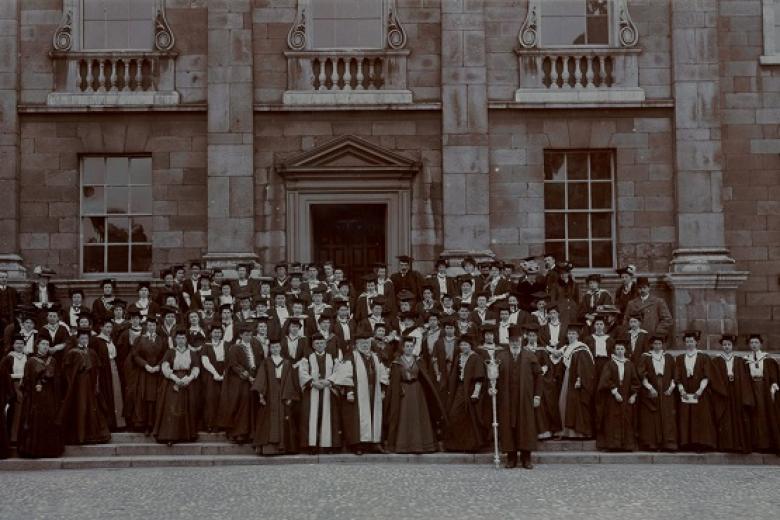 Former students of Girton and Newnham collecting degrees at Trinity College Dublin, taken by Lafayette, Dublin, circa 1904-1906 (archive reference: GCPH 13/52)
Former students of Girton and Newnham collecting degrees at Trinity College Dublin, taken by Lafayette, Dublin, circa 1904-1906 (archive reference: GCPH 13/52)
Resident domestic staff
The daily life of a College like Girton is powerfully shaped and supported by the work of its domestic staff. In its early decades the College employed an expanding number of resident women to carry out many domestic tasks.
Pictured here are some of the domestic staff of 1908, together with one of the young boys employed to run errands and clean the College laboratory.
Most of these women lived in shared rooms above the Scullery (now the College Kitchens) and in ‘Top Boots’. They included a Housekeeper and her assistant, a Portress, three Cooks, a Linen Maid, and groups of Kitchen, Pantry, Parlour and House Maids.
Men were employed as Garden and Maintenance staff, but none of these lived in the main College buildings.
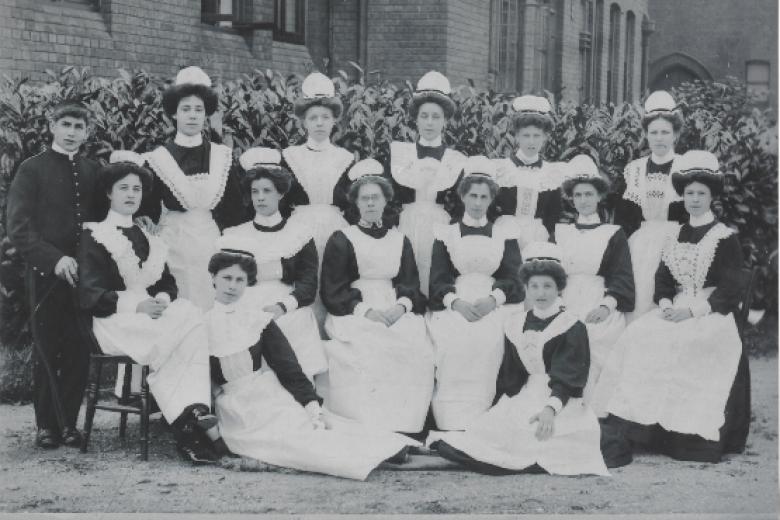 The domestic staff taken by Starr & Rignall, circa 1907-1908 (archive reference: GCPH 8/1/7)
The domestic staff taken by Starr & Rignall, circa 1907-1908 (archive reference: GCPH 8/1/7)
The first Fellow
By 1910, original academic research had grown in importance across the University. In that year, Girton appointed its first Fellow – Eugénie Strong (1860–1943), who would today be called a Senior Research Fellow.
The underlying goal was to develop Girton’s identity as an institution supporting research, both for its own sake and to enhance the learning environment. Eugénie Strong was a renowned archaeologist and art historian.
She had read for the Classical Tripos at Girton from 1879 to 1882, and in 1909 had been appointed Assistant Director of the British School at Rome, where she welcomed and corresponded with scholars from around the world.
In the course of her career, Eugénie received many honours. She was appointed a Commander of the British Empire in 1927 and in 1938 she was awarded the Serena medal for Italian studies by the British Academy. She received honorary degrees from the universities of St Andrews and Manchester.
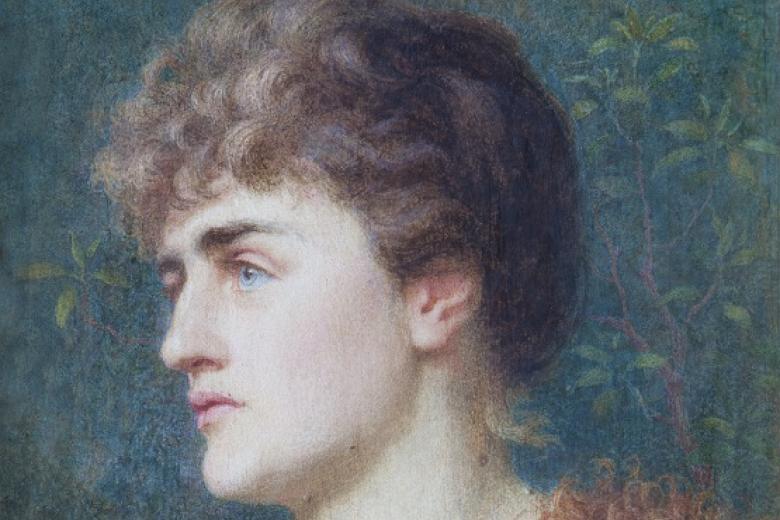 Portrait of Eugenie Strong by Constance Phillott, 1890 (archive reference: GCPH 11/33/33)
Portrait of Eugenie Strong by Constance Phillott, 1890 (archive reference: GCPH 11/33/33)
Another defeat
Katharine Jex-Blake (1860–1951) was the eighth Mistress of Girton, and a celebrated classicist long remembered as a fierce but inspiring teacher.
Mistress from 1916 to 1922, she presided over Girton’s Silver Jubilee and was an able, financially astute administrator. She was also remembered for her sense of humour and her ‘uncanny knowledge of things she could not possibly know’ about the students.
After steering College through the final throes of the First World War, she had to endure the disappointment of 1920 when the University voted once again to deny women membership. Although titular degrees were granted in 1921, these came without the associated privileges, such as participation in University government. Adding insult to injury, the combined number of undergraduates at the two women’s colleges, Girton and Newnham, was capped at 500 (under 10% of the Cambridge total). Nevertheless, Katharine Jex-Blake is remembered as a strong Mistress who pointed the College firmly towards a new phase of institutional development.
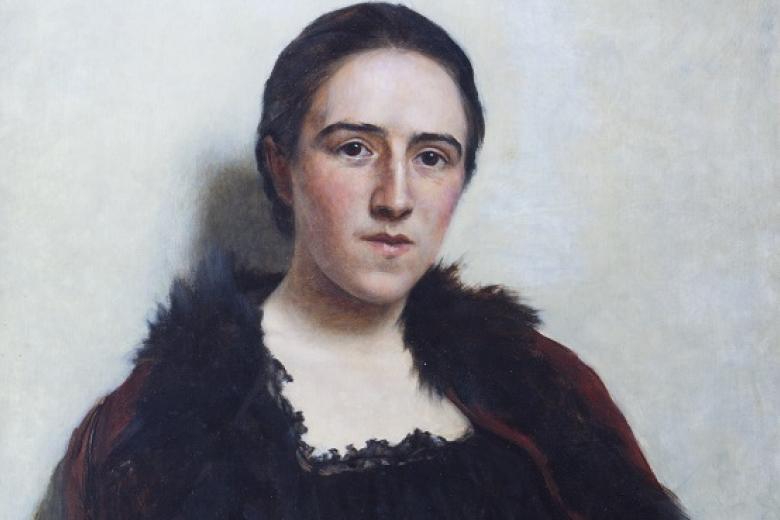 Portrait of Katharine Jex-Blake by Herman G Herkomer, not dated (archive reference: GCPH 11/33/63)
Portrait of Katharine Jex-Blake by Herman G Herkomer, not dated (archive reference: GCPH 11/33/63)
Marjorie Tappan Hollond
One of the most important offices in any College is that of Bursar. In 1946, Girton appointed a new Bursar who was University Lecturer and Girton Director of Studies in Economics, Marjorie Tappan Hollond (1895–1977).
Born and educated in the USA, she was first appointed Girton Director of Studies and Lecturer in Economics in 1923. Bursar until 1963, she steered College finances in a period of great significance, following the 1948 admission of women to the University. She oversaw the adjustment of College accounting procedures to harmonise with university practice, and took a key role in drafting the revised College Statutes of 1954.
The University also recognised her financial talents – she was a member of the Financial Board from 1951 to 1962. Marjorie Tappan Hollond was a colourful character, remembered for her wit, elegance, and striking appearance.
She had a passion for Bentley cars, travel and the art and culture of Russia and China. Married in 1929 to a Fellow of Trinity, she remained resident in College until retirement.
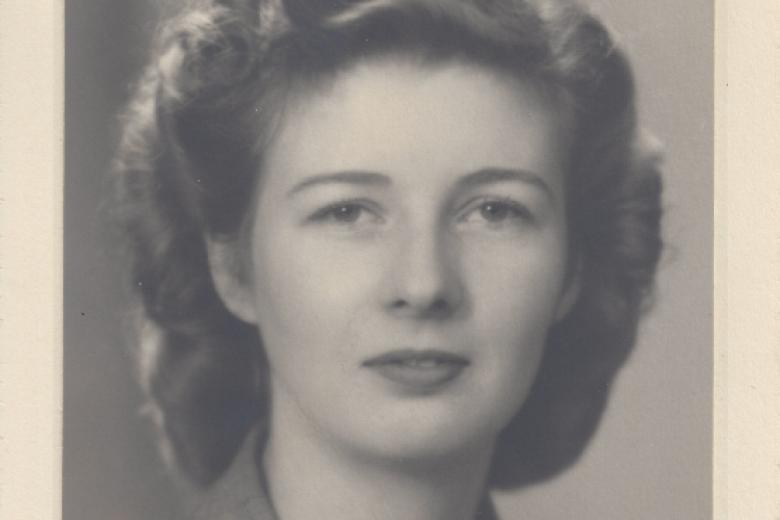 Studio portrait thought to be of Marjorie Tappan, taken by Elliot and Fry, circa 1925 (archive reference: GCPP Hollond 1/6/5).
Studio portrait thought to be of Marjorie Tappan, taken by Elliot and Fry, circa 1925 (archive reference: GCPP Hollond 1/6/5).
Mary Cartwright
Dame Mary Cartwright (1900–1998), thirteenth and longest-serving Mistress of Girton from 1949 to 1968, was a mathematical genius who laid the foundations of a completely new field of science – Chaos theory.
Ironically, given that Mary Cartwright was a scholar of Pure Mathematics, the discovery arose from her determination to resolve a very practical wartime problem of the erratic performance of high power amplifiers used to develop radar. Now widely recognized as the birth of a new branch of mathematics, the significance of this work was overlooked for more than 20 years. Despite her modesty, her brilliance was nevertheless widely recognized.
In 1947, she became the first woman mathematician to be elected to the Royal Society; in 1968 she received the de Morgan Medal which is the highest honour possible from the London Mathematical Society and she was made a Dame of the British Empire in 1969.
Mary Cartwright joined the College in 1930 as a Research Fellow and was variously a Fellow, Lecturer, Director of Studies, Mistress, and Life Fellow of the College for a total of 68 years.
 Dame Mary Lucy Cartwright, by Elliott & Fry, 1950 ©National Portrait Gallery, London
Dame Mary Lucy Cartwright, by Elliott & Fry, 1950 ©National Portrait Gallery, London
'Dig for Victory'
As the Girton community prepared for war, the gardens were once again turned over to growing vegetables and keeping pigs.
The College worked hard to become self-sufficient in vegetables. Crops included onions, carrots, lettuce, cauliflower, celery and tomatoes. Although mushroom production proved difficult, there was a surplus of other produce which was canned or sold. Students recalled the production of vast numbers of potatoes (over 19 tons in 1941–1942) that seemed to move rapidly from turf to plate.
Residents handed in their ration books which the College used to provide the regulated amounts of food stuffs such as sugar, butter and jam. Butter, meat and milk were in short supply, and students were given NAMCO, a cocoa substitute, to make their evening drink.
Across College, domestic and garden staff numbers became very depleted. Remaining male gardeners were often absent with the Home Guard. By 1941 students had to clean their own rooms and were asked to volunteer in the kitchens and gardens or join fire-watching rotas.
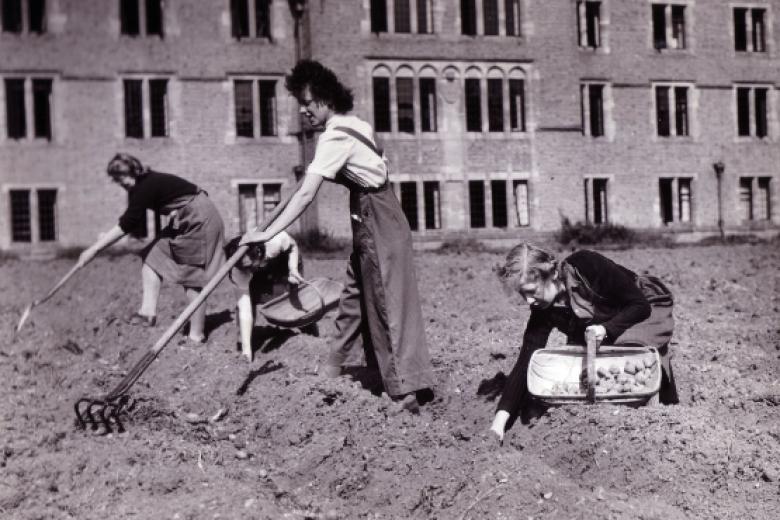 Students raking and collecting potatoes in the College grounds, 1942. Taken by Fox Studios (archive reference: GCPH 10/12/15)
Students raking and collecting potatoes in the College grounds, 1942. Taken by Fox Studios (archive reference: GCPH 10/12/15)
Long serving Fellows
Girton has always been richly served by the commitment of its Fellows. This period in particular saw the appointment of a number of women who supported and inspired students over many decades.
These included eminent Shakespearean scholar Muriel Bradbrook (1909–1993), for over 60 years from 1932, successively a Research Fellow, Lecturer, Fellow, Mistress and Life Fellow of the College.
French scholar Alison Fairlie (1917–1993) joined Girton as a Lecturer in 1944 and was subsequently Fellow, Director of Studies, and Life Fellow until her death – a total of 49 years.
Another distinctive career was that of classicist Alison Duke (1915–2005), Girton’s first Senior Tutor. Appointed Acting Assistant Tutor in 1946, she too was a remarkably long-serving Girton Fellow. For close to six decades, she held the posts of Tutor, Fellow, Lecturer, Director of Studies, and Life Fellow as well as officially becoming the first Senior Tutor in 1968. She was one of the architects of the modern tutorial system in the College.
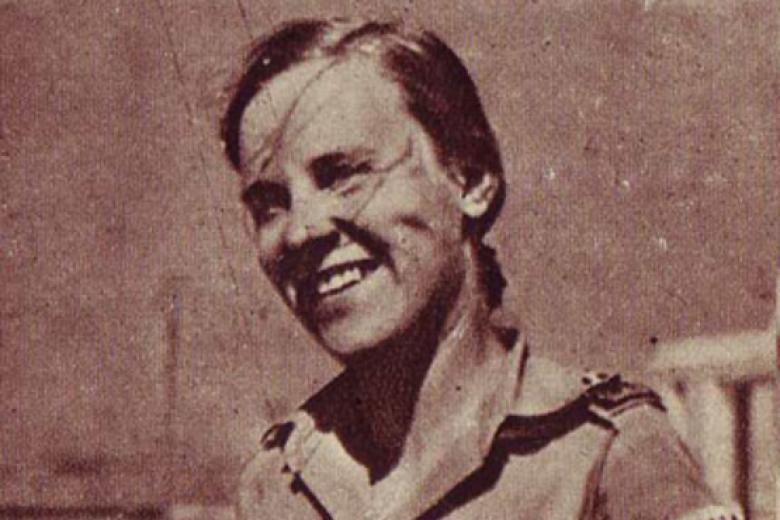 Alison Duke in Egypt enroute to Greece during World War Two, 1945 (photograph: Girlguiding Cambridgeshire East)
Alison Duke in Egypt enroute to Greece during World War Two, 1945 (photograph: Girlguiding Cambridgeshire East)
Third College Visitor
On June 10 1969, Girton welcomed a very special guest to help mark its Centenary. Her Majesty Queen Elizabeth, the late Queen Mother (1900-2002), attended a lunch in the Hall followed by a Garden Party where she met students, Fellows, staff and friends of the College, and other guests from the University and city of Cambridge.
Musical entertainment and relaxation in the sun-filled College grounds were topped off by a ceremonial tree planting, and a champagne toast to the College on its 100-year anniversary.
The Queen Mother held the post of Girton Visitor since 1948 – the third person, and the first woman, to take up that office since its establishment in 1924.
The role of Visitor is to oversee fair play in the application of College regulations, and to resolve disputes arising between the institution and its members.
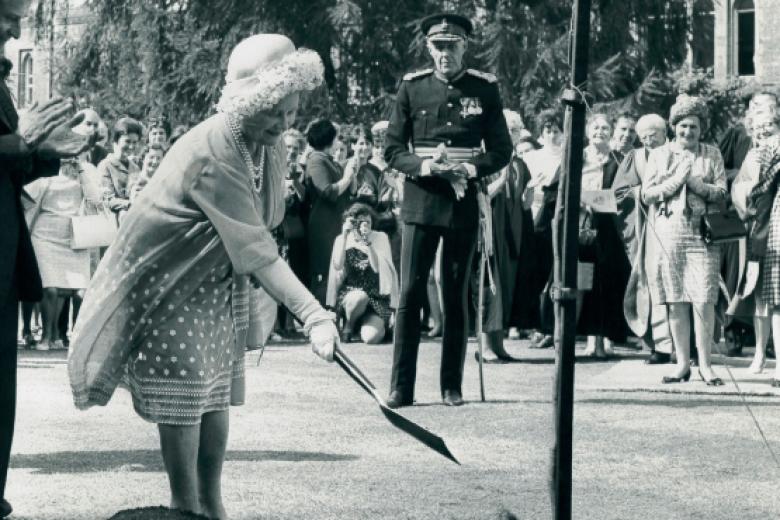 Her Majesty Queen Elizabeth, the late Queen Mother, plants a tree to commemorate Girton’s centenary, 10 June 1969 (photograph: Cambridge News)
Her Majesty Queen Elizabeth, the late Queen Mother, plants a tree to commemorate Girton’s centenary, 10 June 1969 (photograph: Cambridge News)
Portresses
In 1971, Ada Woods retired from Girton after 34 years working in one of the most distinctive offices in College. She was first Assistant then, from 1955, Head Girton Portress. The Portress was a famed figure – part student-support, part door-keeper and lodge, parcel and visitor-manager. She greeted new students on arrival, and quickly came to know them all well. Until the 1970s she lived in a College bed-sitting room. On retirement Ada Woods moved to a Cambridge flat, taking ‘surprisingly happily to housekeeping and cooking after her many years of residence’.
The first Girton Portress we know of was 45 year-old widow Elizabeth Allpress who was in office in 1901. Emily Hill was the longest serving Head Portress who was in post from 1923 till 1955 and fondly remembered by generations of students. After retirement, she too moved to Cambridge city, where she would welcome College friends to tea at ‘about 4pm’.
The modern Porters’ Lodge is staffed night and day by a hardworking team of men and women, though no-one any longer lives-in.
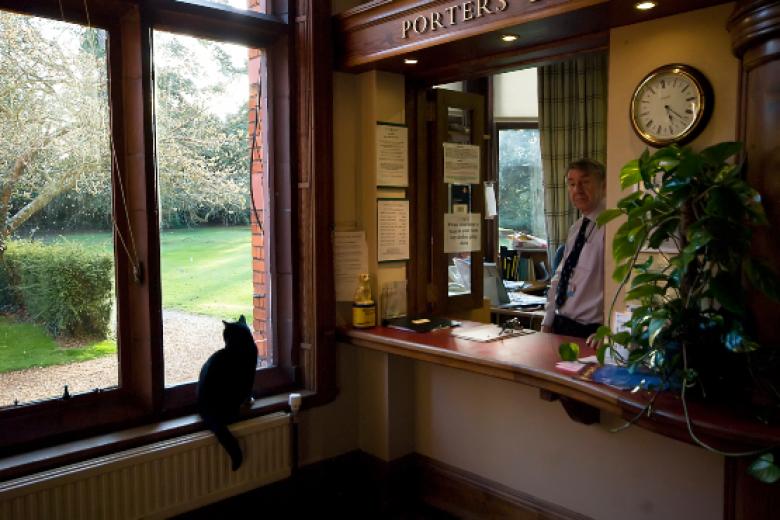 The former Porters’ Lodge, 2012
The former Porters’ Lodge, 2012
First male Official Fellow
On 3 March 1977, Girton formally admitted its first male Fellows: Dr John Marks (1924–1926) and Dr Samuel (Frank) Wilkinson.
Dr John Marks had been Girton’s Co-Director of Studies in Medicine since October 1976 – the beginning of many years encouraging generations of Girton medics. Having qualified as a doctor in London in 1946, John Marks’ wide-ranging career included medical research in Cambridge, 20 years working in the pharmaceutical industry, and a sustained commitment to medical teaching. He was a Fellow and Life Fellow of Girton for almost four decades.
Dr Frank Wilkinson’s connection to Girton also began in 1976, when he was appointed College Lecturer and Director of Studies in Economics. A mature student at Ruskin College, Oxford, and King’s College Cambridge, Frank Wilkinson was a founder member of the think tank, the Institute for Employment Rights, and the Cambridge Political Economy Society (CPES) where he has recently been appointed a Patron. He was also a founder (and remains an) editor of the Cambridge Journal of Economics. His many years of research focussed on the effects of institutions and organisations on economic performance.
John Marks and Frank Wilkinson began a long line of distinguished male scholars on the Girton Fellowship, and both now have College Fellowships named in their honour.
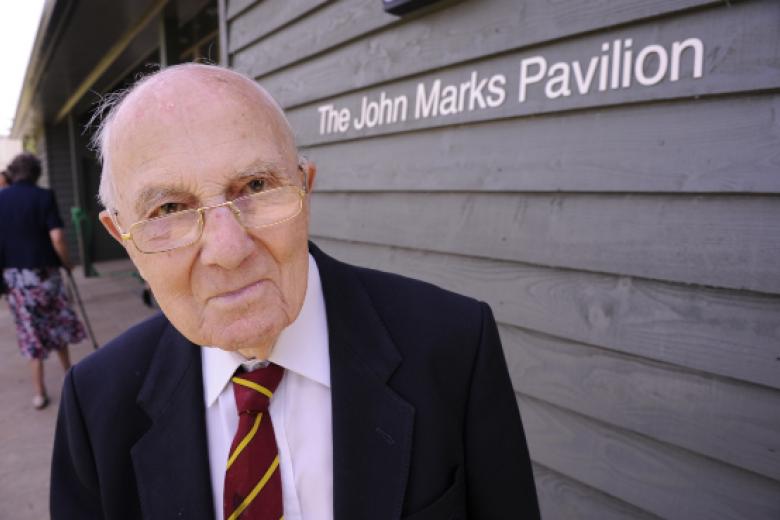 John Marks MA MD FRCP (1924-2016) at the 2011 turf cutting ceremony for the Sports Pavilion named after him
John Marks MA MD FRCP (1924-2016) at the 2011 turf cutting ceremony for the Sports Pavilion named after him
A great tradition of music
1990 was a defining year for Music at Girton thanks to a generous act of philanthropy that led to the establishment of an endowed fellowship in Music. Dr Martin Ennis joined the College in 1990 as the first – and, as yet, only – holder of the Austin and Hope Pilkington Fellowship and as Director of Music.
The momentum provided by the new appointment helped establish Girton as one of the foremost destinations for prospective Music students, and recent Girton graduates have been among the strongest in the University.
Notable Music alumni of recent years include Sasha Siem (2002 Music), Charlie Siem (2005 Music), Mateusz Borowiak (2006 Music) and Benjamin Comeau (2011 Music). The fabric of musical life in Girton has been much enriched by additional appointments in music.
Professor Margaret Faultless, who has held a Bye-Fellowship since 2010, and Jeremy West, Musician-in-Residence since 2011, have helped confirm Girton’s reputation as a centre for early music.
This focus has been enhanced by a sequence of notable Directors of Chapel Music, including Nicholas Mulroy (2011), Andrew Kennedy (2014) and Gareth Wilson (2015).
 Martin Ennis conducting the College Chapel Choir in Hong Kong, 2015
Martin Ennis conducting the College Chapel Choir in Hong Kong, 2015
Going Digital
Computers have significantly impacted on ways of learning for students. At Girton, computer science is a relatively new subject at undergraduate level.
Professor Ted Briscoe joined Girton in 1989 and his research interests – and to date over 100 publications – are on computational and theoretical linguistics, automated speech and language processing.
Herman Narula (2007 Computer Science) is co-founder of Improbable which created SpatialOS, a platform that can be used to build advanced virtual worlds for anything from games to simulations of city infrastructure and cells in the body. His company has expanded from a staff of 50 to 180, and in 2017 finalised a $502 million investment from Japan’s SoftBank Corporation, which is thought to be the largest investment made in a European technology firm.
The College has had three Computer Officers who guided the College – from Val Robson (1992 -1996), Simon Below (1997-2000) and Andrew Leader (2000-2017) – from the first Sinclair word processors and Apple Macs in the 1990s through to today’s fully digitised IT Department with a staff of three, led by Kim Pearson (2017- to date).
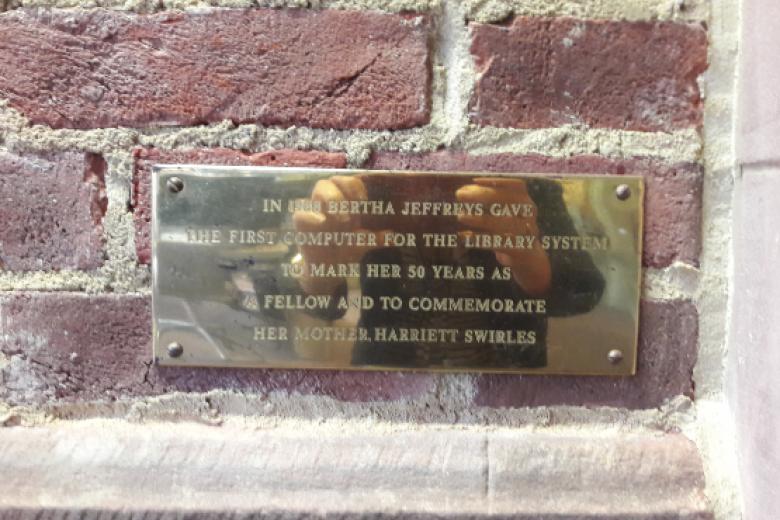 Commemorative gift plaque for Girton Library’s first computer in 1988
Commemorative gift plaque for Girton Library’s first computer in 1988
Fourth Visitor
It is gratifying to note that the most important legal official in the UK is both a woman and an illustrious Girtonian: The Rt Hon the Baroness Hale of Richmond, DBE PC QC FBA (1970, Law) received a starred First for exceptional distinction in that subject.
In 1984, she became the first woman to be appointed a member of the Law Commission, a statutory body set up to promote the reform of the law. There she led the work of the family law team, which eventually resulted in some major pieces of legislation, principally the Children Act 1989 and the Mental Capacity Act 2005. She taught Law at the University of Manchester, becoming a High Court judge in 1994 and a Lady Justice of Appeal in 1999. In 2004 Lady Hale became the first woman to sit on Britain’s Supreme Court and she was appointed Deputy President in 2013 and President of the Supreme Court in 2017.
Lady Hale became an Honorary Fellow of the College in 1995, before being appointed the College's Visitor in 2004, a role she continues to hold.
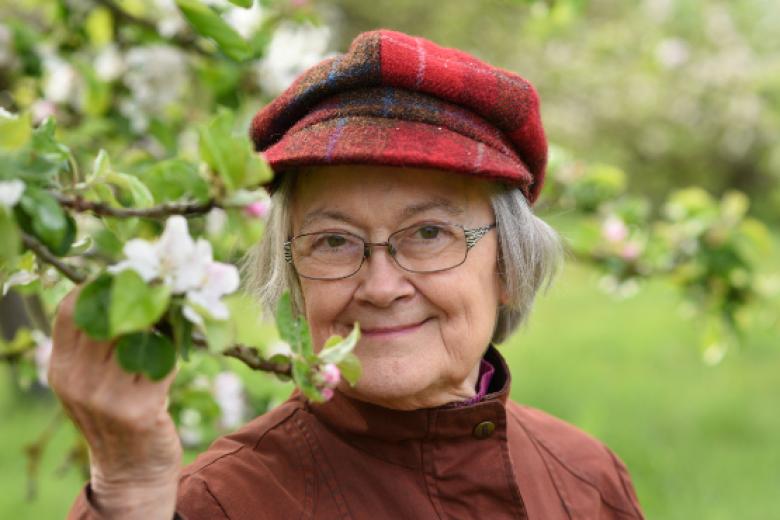 Lady Hale in the College Orchard, 2 May 2019
Lady Hale in the College Orchard, 2 May 2019
Four Girton Mistresses and a cat
This is a photograph of Baroness Mary Warnock DBE, Mistress from 1984 to 1991, Juliet Jeanne d’Auvergne Campbell, Mistress from 1991 to 1997, Professor Dame Marilyn Strathern DBE (1960 Archaeology and Anthropology) Mistress from 1997 to 2009 and Professor Susan J. Smith, Mistress from 2009 to 2022.
All four Mistresses signed the legacy letter, highlighting the importance of legacies for the financial sustainability of the College. Their range of academic disciplines from Philosophy to Economics, Anthropology to Geography highlights the breadth of subjects taught at Girton.
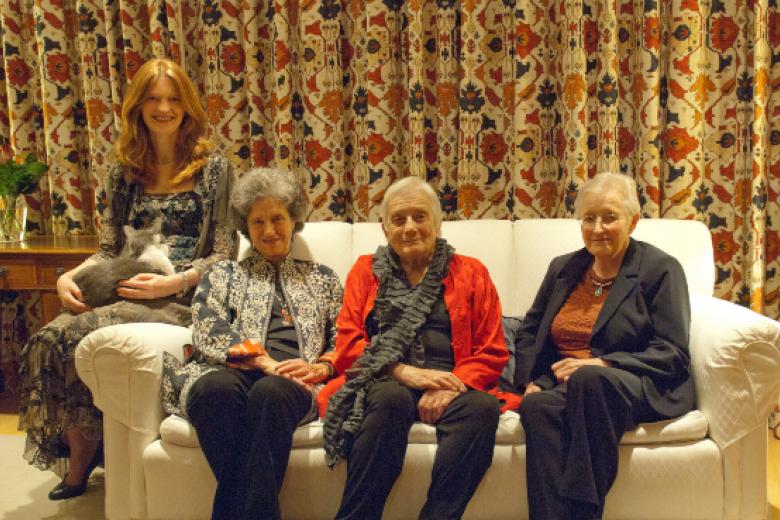 Four previous Mistresses of Girton, 2015
Four previous Mistresses of Girton, 2015
A growing global family
Girton recruits globally and educates for an international job market. Worldwide, therefore, we are in touch with nearly 10,000 alumni. Most are based in the UK but internationally the network includes 44 countries including south and east Asia, mainland Europe and the west and eastern seaboards of North America.
As Cambridge cements its position at the centre of the world’s educational stage, and as Girton’s graduate school grows, our alumni networks will continue to expand globally. Girtonians achieve extraordinary things; as role models, mentors, colleagues, friends and supporters ‑ in every possible way ‑ our alumni represent one of our most valued and valuable resources.
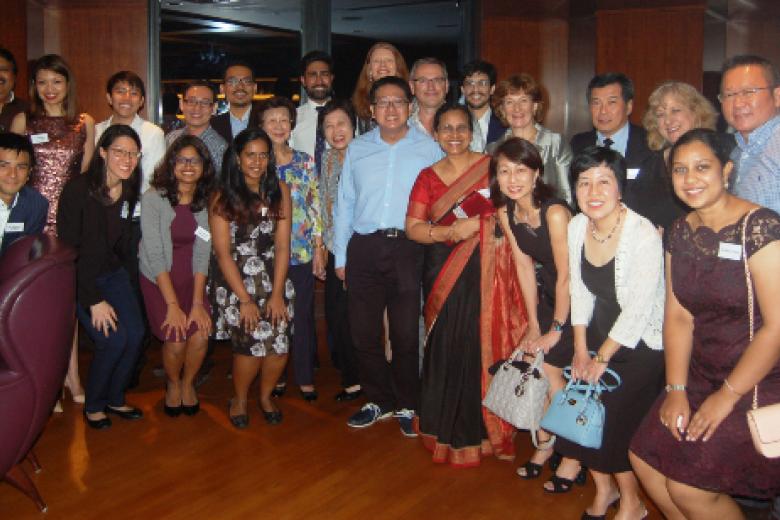 The Mistress, Professor Susan J Smith, hosts an event in Singapore for Girton’s growing international alumni community, 2017
The Mistress, Professor Susan J Smith, hosts an event in Singapore for Girton’s growing international alumni community, 2017
Girton's gardens rejuvenated
Emily Davies (1830–1921) envisaged in 1866 a beautiful College:
"with gardens and grounds and everything that is good for the body, soul and spirit."
Acclaimed garden designer, Gertrude Jekyll (1843–1932) drew up planting plans for Cloister Court and Emily Davies Court, but it was Elizabeth Welsh (1843–1921), Girton’s sixth Mistress, who created the heart of the historic garden. The pond, Yew Walk, Home Garden, Fellows’ Garden and Old Orchard are all part of her legacy.
In the 1980s, conservation meant the creation of wild flower meadows and heritage apple collections; in 1983, 60 bird species were noted, and over 100 species of moths in 1986. In 1992, the distinguished designer Penelope Hobhouse created a new ‘green theatre’ design for the Fellows’ Garden.
For the 150th Anniversary, the College Garden Team re-created the historic planting scheme in Honeysuckle Walk, which included two donated sculptures of carved apple and chestnut, both entitled Gazelle by Christine Fox (1922–2012). There was a formal re-opening at the Girton150 Festival.
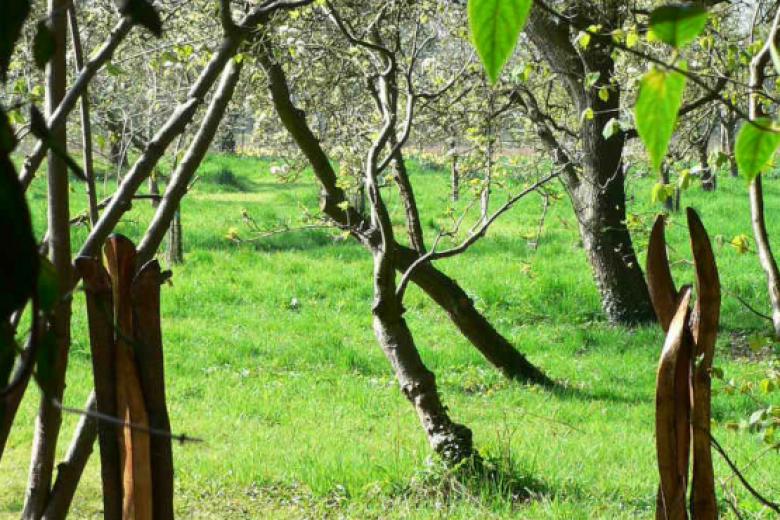 Two donated sculptures by the late Christine Fox adorn Honeysuckle Walk, 2017
Two donated sculptures by the late Christine Fox adorn Honeysuckle Walk, 2017
Newly honoured by the College
One of the perennial riches of any college is their ability to bestow Fellowships on individuals who have achieved distinction in their chosen careers and lives outside College.
In this way the vibrancy and intellectual diversity of the community is strengthened. Accordingly, and on the nomination of the Council, the Governing Body may at any College meeting confer the title of Honorary Fellow upon a person of distinction, whether a past student of the College or not, for the duration of her life.
Since Professor Anita Desai, CBE BA (Delhi) FRSL was elected in 1988, a further 26 Honorary Fellows have been admitted.
Five new Honorary Fellows were admitted during 2019, our 150 Anniversary year, in tribute to our first five pioneering students in 1869. These were HIH Princess Takamado (Chinese, Archaeology and Anthropology), Professor Dame Pratibha Gai (physics), Sandi Toksvig (Archaeology and Anthropology), Her Excellency Dame Karen Pierce (English) and Dr Suzy Lishman (Medicine). This takes Girton up to its full complement of 30 Honorary Fellows.
 Sandi Toksvig being admitted as an Honorary Fellow on 9 May 2019
Sandi Toksvig being admitted as an Honorary Fellow on 9 May 2019
